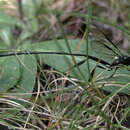ar
الأسماء في صفحات التنقل


Pelecinus polyturator is a species of wasp in the family Pelecinidae. The large (up to 7 cm) glossy black insects are the most common and well-known members of the family. The adults drink nectar, and they live in crop fields, woods, and suburban gardens throughout North, Central, and South America. Their antennae are long and the females have an elongated, cylindrical, articulated metasoma. They are parasitoids that lay their eggs directly into grubs of the June beetle (genus Phyllophaga) buried in the soil. The adults can be found in the late summer.
Some populations of Pelecinus polyturator are parthenogenic; females do not require fertilization by males to reproduce. Females are common throughout its range, but males are rare in the United States and Canada specially in some populations, and more common farther south.[1]
Pelecinus polyturator is a species of wasp in the family Pelecinidae. The large (up to 7 cm) glossy black insects are the most common and well-known members of the family. The adults drink nectar, and they live in crop fields, woods, and suburban gardens throughout North, Central, and South America. Their antennae are long and the females have an elongated, cylindrical, articulated metasoma. They are parasitoids that lay their eggs directly into grubs of the June beetle (genus Phyllophaga) buried in the soil. The adults can be found in the late summer.
Some populations of Pelecinus polyturator are parthenogenic; females do not require fertilization by males to reproduce. Females are common throughout its range, but males are rare in the United States and Canada specially in some populations, and more common farther south.
Pelecinus polyturator es una avispa negra brillante grande (hasta 7 cm), la especie más común y familiar de la familia Pelecinidae. Los adultos beben néctar. Viven en campos de cultivo, bosques y jardines suburbanos a lo largo de América del Norte, Central y del Sur. Sus antenas son largas y las hembras tienen un metasoma articulado, cilíndrico y alargado. Son parasitoides que ponen sus huevos directamente en las larvas del escarabajo de junio (género Phyllophaga) enterrados en el suelo. Los adultos se pueden encontrar a finales del verano.
Algunas poblaciones de Pelecinus polyturator son partenogénicas; Las hembras no requieren la fertilización de los machos para reproducirse y pueden producir machos y hembras. Las hembras son comunes en todo su rango, pero los machos son raros en los Estados Unidos y Canadá, especialmente en algunas poblaciones, y más comunes en el sur.[1]
Pelecinus polyturator es una avispa negra brillante grande (hasta 7 cm), la especie más común y familiar de la familia Pelecinidae. Los adultos beben néctar. Viven en campos de cultivo, bosques y jardines suburbanos a lo largo de América del Norte, Central y del Sur. Sus antenas son largas y las hembras tienen un metasoma articulado, cilíndrico y alargado. Son parasitoides que ponen sus huevos directamente en las larvas del escarabajo de junio (género Phyllophaga) enterrados en el suelo. Los adultos se pueden encontrar a finales del verano.
Algunas poblaciones de Pelecinus polyturator son partenogénicas; Las hembras no requieren la fertilización de los machos para reproducirse y pueden producir machos y hembras. Las hembras son comunes en todo su rango, pero los machos son raros en los Estados Unidos y Canadá, especialmente en algunas poblaciones, y más comunes en el sur.